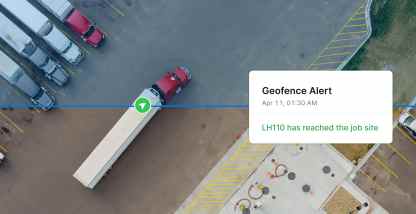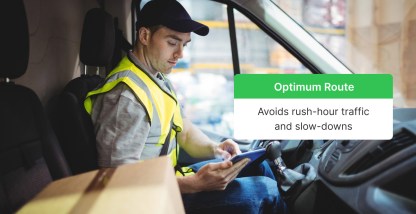A telematics system and fleet management software can help fleet managers and decision-makers improve their day-to-day workflow for smarter and faster fleet operations.
What is telematics?
Telematics is the process of transmitting information remotely over long distances. Today, telematics is used in various industries for commercial and non-commercial purposes.
Telematics blends two science disciplines: telecommunications and informatics. “Telecommunications” refers to communication over a distance, and “informatics” is the practice of information processing.
A decade ago, the word telematics didn’t even exist. Due to the rise of the internet and communication over networks, it has become a critical aspect of successful fleet operations.
Telematics has helped various industries improve communications, efficiency, and customer service by allowing seamless, remote data transfer and increasing visibility into operations.
What is fleet telematics?
The trucking industry uses fleet telematics to gather data using a combination of GPS technology, sensors, and onboard diagnostics codes. The gathered data generally includes vehicle location, driver behavior, vehicle activity, and real-time engine diagnostics.
Fleet owners and managers can manage assets remotely using telematics technology via a designated software or platform.
A fleet telematics system usually consists of two components:
- The GPS tracking device, which is generally installed in the vehicle’s on-board diagnostic port
- The fleet communication software system, most often located at a dispatch center or fleet manager’s office
Fleets within the trucking industry usually install telematics devices and accompanying fleet management software to collect and transmit a broad range of information.
That information can comprise:
- Vehicle maintenance issues
- Vehicle location via real-time GPS and asset tracking
- Vehicle usage
- Fuel consumption
- Rapid acceleration
- Hard braking
- Hard cornering
- Idling time to minimize fuel consumption
- Speeding
Information from telematics and GPS fleet tracking systems provide in-depth insights into the fleet. Fleet managers can then use these insights to help identify at-risk drivers, improve fleet safety, reduce fuel waste, and lower operating expenses.
How does telematics work?
The following infographic explains how data is transmitted remotely via telematics.
The telematics device is generally connected to the vehicle’s onboard diagnostics port with a SIM card. A modem allows communicating the collected data via a wireless network to a central server.
The server then reads the data and displays it through a secure website, either on a computer or mobile application, enabling the end user, such as a fleet manager, to interpret the data and make more informed decisions regarding fleet efficiency.
What industries use telematics systems?
The most common industries that use telematics systems are:
- Delivery and courier companies
- Field sales and services, such as plumbing, heating, ventilation, and air conditioning (HVAC), etc.
- Trucking and transportation logistics
- Car rental and leasing companies
- Towing companies
- Food and beverage businesses
- Construction companies
- Utilities
- Transit fleets, such as motorcoach, public transit, taxi, and paratransit
- First responders, police, and other public agencies
- Landscaping
- Oil, gas, and mining industries
- Waste management fleets
Why install a telematics device?
Many fleets see telematics as a crucial technology for fleet management.
Safety is one of the biggest reasons fleet owners install telematics. Other features include in-vehicle coaching, driver behavior reporting, incident notification and reconstruction, and tracking stolen vehicles.
Improved customer service is another reason. Using real-time GPS tracking, trip reporting, and routing tools improves productivity and helps fleets provide better service to their customers.
Cutting delivery times is also a benefit that’s top of mind for fleet managers. With a quality telematics system, dispatchers and fleet managers can accurately track their fleet to determine when their drivers arrive at their destination.
The ability to tell a customer exactly where their cargo is and precisely when it will arrive can quickly help build trust between the company and the customer. Integration with onboard camera technology is another area where telematics is helpful.
For example, when Motive customer Nybll, a California-based health food service provider, was involved in a collision, their driver was exonerated due to video proof from an installed dashcam.
How are telematics devices installed in trucks?
Some telematics devices are plug and play, while others require engineers and support staff for proper installation and setup. The power requirements of telematics devices also vary. They can either be battery-powered or powered by the vehicle’s internal electrical system.
What other vehicles can use telematics?
Telematics can perform a number of functions in multiple vehicle types and assets, including:
- Heavy equipment. The construction industry typically uses telematics for heavy earth-moving equipment. It can track equipment utilization to boost job site productivity, reduce fuel burn, and enable preventative maintenance.
- Cars. Besides performing crucial vehicle maintenance and productivity functions for company car and sales fleets, telematics is also used to track private mileage. This helps ensure health and safety compliance, which is a vital aspect of an employers’ duty of care.
- Single axle and tractor units. Telematics helps with route optimization and scheduling, driver hour management, fuel management, and driver behavior reporting for tractor and single axle unit operations.
- Cargo vans and pickup trucks. Companies with pickup trucks and cargo vans in their fleet often use telematics for time-on-site reporting. Other uses include job dispatching and routing, making timesheets as proof of delivery solutions, reporting, tracking driver behavior, and monitoring unauthorized vehicle use.
- Buses and coaches. Telematics helps streamline driver hour management, fuel management (including engine idling), and route optimization and scheduling. Bus and coach fleets also use telematics for driver behavior reporting and service integrations (i.e., through time of arrival alerts).
- Specialist vehicles. A range of specialist vehicles, including dump trucks, tow trucks, and cement trucks, use telematics. The technology allows users to better understand vehicle activity through power take-off and where mechanical power is transferred to other pieces of equipment.
How can my fleet use a telematics system?
Fleets of all types and sizes can use and benefit from a telematics system. Telematics data empowers fleet managers and administrators to solve unique business challenges and make data-driven decisions.
It provides valuable information on each vehicle or asset’s location, which can help:
- Fleets gain visibility into operations
- Increase efficiency and productivity
- Prevent vehicle theft
- Provide better delivery estimates to clients
- Increase customer satisfaction (and potentially save thousands of dollars)
Benefits of a telematics system
With advanced telematics systems and data, fleets can simplify operations and driver management and get a better return on investment (ROI).
Here are eight benefits of telematics for fleets of all types and sizes:
1. Increased efficiency and productivity
Telematics for fleet management allows for real-time vehicle location tracking through GPS. With the help of real-time vehicle monitoring and location history, fleet managers can identify the best and most efficient routes, improve driver safety, speed up deliveries, and minimize fuel expenditures.
Apart from using a real-time fleet GPS tracking solution, geofencing can also play a key role in increasing efficiency and productivity. Geofencing allows for tracking performance against delivery schedules and can also help reduce detention time. On average, driver detention at shippers and receivers can cost up to $1,280 per driver per year.
2. Reduced fuel wastage and operational expenses
Fleets use telematics systems to determine the quickest and shortest routes, which cuts delivery times. Through smart route planning, fuel efficiency improves since vehicles aren’t consuming fuel by traveling long routes. Telematics systems can also reduce vehicle idling since they can identify which drivers are idling too long.
Fleet managers can ask drivers with unusually long idle times about the challenges they’re facing so they can come up with a solution.
Some fleet management software can automate idle tracking and present vehicle utilization rates for each driver. Through smarter route planning, monitoring idling across your fleet, and leveraging a reliable maintenance fuel solution, you can significantly cut down your operational expenses.
3. Better payroll management
Fleet managers can automate employee records and streamline payroll management. Automating helps ease administrative and clerical work and minimize errors. It becomes easier to calculate payroll when you know exactly how far and for how long each vehicle was driven.
4. Improved safety
Safety is a top priority for fleets of all types and sizes. Even a small collision on the road can potentially cripple a business.
According to the FMCSA:
- The average cost of a collision involving a fatality is $3,600,000.
- A collision with injuries costs nearly $200,000.
- The average cost of collisions is reportedly $91,000 per incident.
Combining the power of a modern-day fleet safety solution, fleet management software, and telematics systems enable fleets to correct and improve driver behavior and increase road safety.
Fleet management software can rank drivers based on safety scores as the system collects more behavior data. This helps safety managers identify drivers with the worst and best performances across the fleet so they can develop driving coaching programs.
5. Driver exoneration
According to a large truck crash causation study, 56% of passenger vehicles and 44% of trucks were responsible for crashes in two-vehicle accidents between a truck and a passenger car.
But without any evidence, fleets have no way to exonerate their drivers when they’re not at fault. Dashcam footage can change that. Dashcam-recorded video footage is almost always admissible in court, and fleets can use it to exonerate innocent drivers and save the company from potential liabilities.
D&A McRae Transportation is a fleet whose driver was saved with the help of footage recorded by the Motive Smart Dashcam.
Rod Conrad, the Terminal Manager with D&A McRae, says, “We would have immediately been deemed to be at fault. Footage from Motive’s Smart Dashcam exonerated our driver and saved us what could have been close to $50,000 in damages. From this one incident, the Smart Dashcam paid for itself.”
6. Proactive vehicle maintenance
One of the biggest benefits of using telematics is identifying vehicle maintenance issues remotely and alerting the team in real time. Fleet managers can leverage automation features to schedule preventive maintenance after taking Hours of Service (HOS) information into account. According to the CVSA International Roadcheck 2019 results, 16,347 vehicles went out of service that year — out of 24% of the total inspections.
The top three out-of-service vehicle conditions were:
- Braking systems (28%)
- Tires and wheels (19.3%)
- Brake adjustment (17.1%)
Advanced telematics lets you catch many vehicle maintenance issues early with vehicle fault-code detection and real-time alerts. This can help you quickly identify potential vehicle issues, prevent critical violations, safeguard CSA scores, and potentially save thousands of dollars.
7. Streamlined communication
Fleet management software allows for more streamlined communication between drivers and back office staff.
Better communication, along with accurate vehicle location tracking and geofencing, can help you provide better delivery estimates to your customers and keep them happy.
8. Reduced unauthorized use
Telematics can track drivers via a driver identification system. When fleet managers detect drivers using vehicles they shouldn’t be, they can contact the driver to inform them of the mistake.
For example, drivers might mistakenly use vehicles that are scheduled for repairs and end up causing a crash on the road
How much does telematics cost?
Figuring out the cost of a telematics system is a relatively straightforward process. You often pay for the cost of the device, installation, and a monthly subscription fee.
When you incorporate a telematics system into your fleet, you’re paying for valuable information, such as vehicle data and insights that you otherwise wouldn’t be able to obtain. Most telematics systems currently on the market have reasonably clear-cut costs that you can evaluate.
Fleet telematics costs
First, you’ll pay for the device itself. Depending on the size of your fleet, many telematics companies offer quantity discounts.
Telematics device cost variables
The cost of the device largely depends on the type of device you choose.
Some telematics devices transmit data in real time, while others transmit at a predetermined interval, such as every hour or half-hour. A device that transmits in real time is a smarter device with more advanced technology built in.
Opting for a cheaper device that transmits data only at certain intervals can cause delays in trucking operations and hinder fleet managers from taking immediate action in case of emergencies.
Telematics installation costs
The next factor affecting the overall cost of the telematics system is installation. The best devices are plug-and-play and can easily be installed into the vehicle diagnostic port. Sometimes, vehicle telematics companies don’t charge for installation.
Other devices may require a technician to install. If you choose a device that needs to be hardwired or retrofitted, the installation costs will be higher.
Monthly subscription fees
Finally, the monthly subscription fee will determine the total cost of your fleet telematics system.
Since the data provided by telematics systems is critical to optimizing fleet operations and lowering the cost of doing business, it’s important to choose a highly-rated and reliable service provider. There are much cheaper solutions but they often only offer the most basic features and poor support.
The future of telematics
Telematics is an essential component of the trucking and transportation businesses. Many fleets acknowledge that the system could pay for itself in savings elsewhere.
The trucking industry is evolving with the introduction of electronic logging devices and the ELD mandate. There’s also a renewed focus on technology and safety.
Fleet management software and telematics devices will continue to play a major role for fleets looking to gain a competitive advantage. After all, telematics data can help fleet administrators become more proactive and efficient.
To discover how the acquisition of telematics can benefit your fleet and business, give us a call at 844-325-9230. You can also request a free demo of Motive’s all-in-one fleet management and telematics solution and experience the benefits firsthand.








